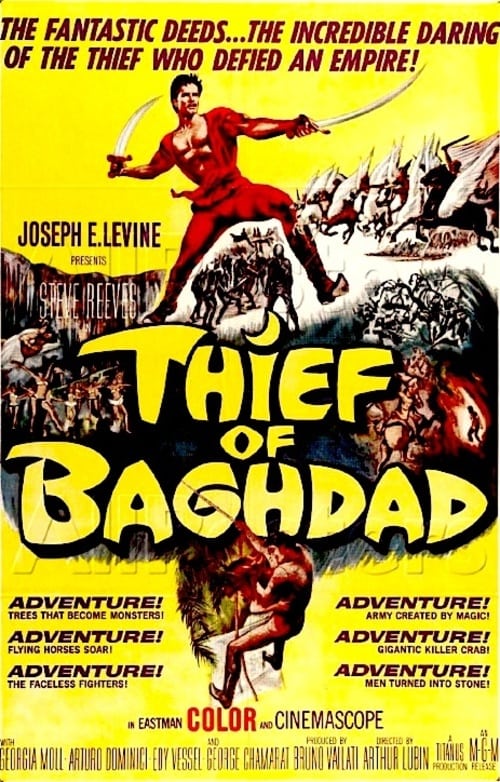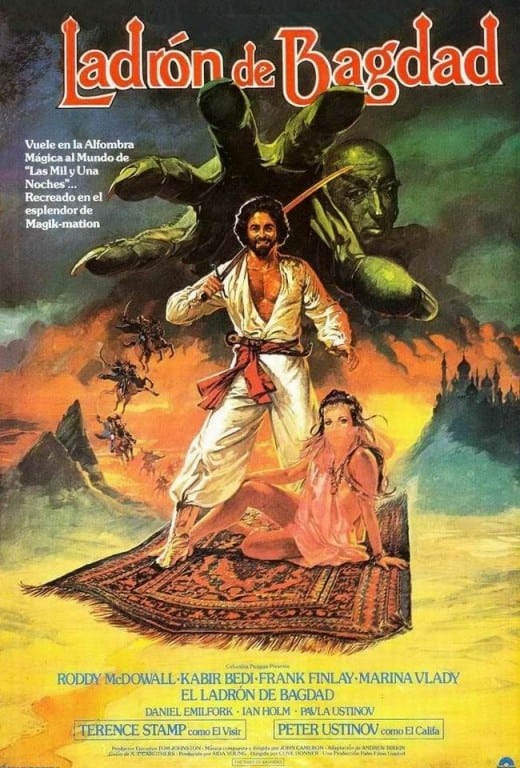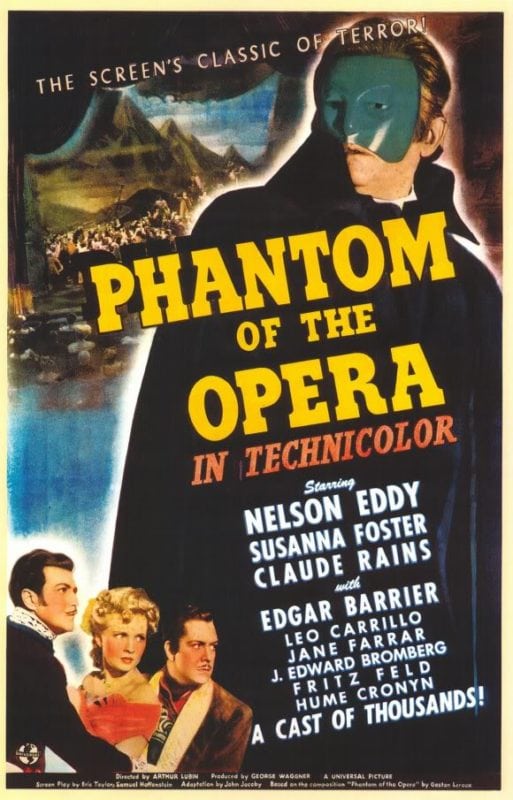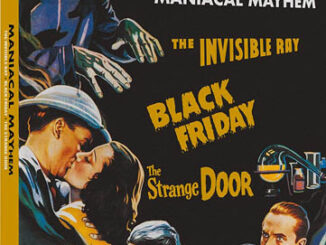The Thief of Baghdad (1961)
Directed by: Arthur Lubin
Written by: Augusto Frassinetti, Bruno Vailati, Filippo Sanjust
Starring: Arturo Dominici, Edy Vessel, Giorgia Moll, Steve Reeves
USA
AVAILABLE ON BLU-RAY [REGION 2 GERMANY], DVD [REGION 2 ITALY]
RUNNING TIME: 92 min/95 mins
REVIEWED BY: Dr Lenera, Official HCF Critic
REVIEW AMENDED ON 23/1/2021 BECAUSE OF THE REGION 2 BLU-RAY
Karim is a thief who steals from the rich and gives to the poor. He daringly conducts a series of thefts at a reception held by the Ali Bajazeth Sultan of Baghdad for the visiting Prince Osman by posing as the prince. Fleeing, Karim hides in the room of the Sultan’s daughter Princess Amina, from whom he stole some jewels, and the two fall in love at first sight. However, the real Osman has come to ask the Sultan for Amina’s hand, and when she rejects him, the Sultan’s devious Vizier Ghamal goes to Osman, offering him a potion that will make Amina love him. He’s also about to aid Osman in his plans to take control of Bagdad….
The third and fourth versions of The Thief Of Bagdad, both spelling Bagdad the original way, are not nearly as well known or as widely seen as the first two versions, and neither are they anywhere near as good, but they still have a fair bit to recommend them. This 1961 version was quite hard to find, and the DVD I did obtain was recorded from video so wasn’t of great quality, though thankfully it recently came out on Blu-ray in Germany hence some updating of this review. It’s a most enjoyable fantasy adventure in its own right, if in approach more along the lines of the Ray Harryhausen Sinbad films then the previous two versions of The Thief Of Bagdad. It remakes the 1924 version rather than the 1940 one, meaning that there’s no boy hero [though Karim does have a young boy aiding him in a few scenes] and no genie. It’s far less artistic, but this simpler, more straight-forward rehash of the Douglas Fairbanks-starrer is still worth hunting down for fans of old fantasy movies and doesn’t disgrace the tail. It’s also far more comedic than all the other versions, which helps to distinguish it and give it more than a right to exist. I didn’t entirely know what to expect when I watched it, especially considering what reviews of this film [which seems to be a nostalgic favourite of many who saw it at the cinema as a child] do exist vary wildly in quality.
It was an Italian production made in collaboration with MGM, at the height of the Italian ‘peplum’ [‘peplum’ being a tunic] or ‘sword and sandal’ fad, where dozens of films set in ancient times emitted from the country, often starring bodybuilders as classic heroes such as Hercules, Ulysses and Samson. Many of them were shown, and were popular [I can’t imagine either now], outside Italy, the first two Hercules movies being especially major US hits because of distributor Joseph E. Levine’s promotion. As regards quality – well it often varies but ‘cheap and cheerful’ is the phrase I would probably use for the ones that I’ve seen. The Thief Of Baghdad reunited Levine with star Steve Reeves, who had played Hercules, and it seems that much more money was pumped into the film than normal. Some sources say that ten minutes were cut for export release, and there were a few times on the DVD where scenes ended abruptly and music even faded out extremely suddenly, though nothing plot-wise appeared to be missing. Examining the uncut German Blu-ray revealed that those flaws were still present and only three minutes had been removed, all of them tiny portions of scenes mostly involving Amina and her maid which don’t play much differently, plus the poor people sorting out Karim’s blue outfit to go on his quest. However, one tiny cut was worthwhile. When Karim and Amina are romancing, he gives her a jewel which she says is her father’s – which it is because he stole it – yet she doesn’t get upset at him, which is stupid. Removing her line is an improvement The Thief Of Baghdad was a reasonable hit, though seemed to fade into near-oblivion.
The first thing that strikes you about this version, compared to the previous two which were mostly studio bound, is that it’s actually largely shot on location in an Arabic country [Tunisia] and uses actual Arabic buildings and extras. This means that it lacks some of the magical, dreamlike feel of the other two, which largely took place on exotic sets but instead looks and feels a bit more realistic, something helped by the casting of Reeves, who looks quite Middle Eastern except for his blue eyes. The costumes though seem to be a strange mix of whatever they could find, and of course the more fantastical second half of the film uses more sets and models. As usual for versions of this story, the first half sets up the adventuring of the second half, but the second thing that is striking is that quite a bit of it is played for laughs, especially the character of Sultan Ali Bajazeth, who keeps forgetting things, and far from being laboured it’s quite funny. You would expect the film’s elaborate and very well worked out opening sequence, where Karim steals from various people including even the Princess in full view of everyone, to be amusing, but the light tone continues throughout. Saying that, a sequence, which seems to just pad out the running time, where Karim manages to escape from prison is just stupid. A shooting star passes in the sky and Karim fools the guards into believing that shooting stars becomes pearls, then throws a handful of pearls on the ground and slips out while they are squabbling for them. Sometimes an odd, bumbling genie, who I initially thought was just a wizard, wonders in and out of the story, eventually taking the role of the old man from the 1924 version.
The love story in this version, which as I’ve said before remakes the 1924 one so let’s ignore the 1940 one from now on, is a bit simpler, with less of a guilt element. The two fall in love at first sight and that’s it. Amina even knows he’s not the man he’s supposed to be very early on and is okay with that. Even condensed here, there’s still a lovely idealised view of romance that is a major plus of all versions of this tale. As in 1924, there are several suitors who set on a quest, this time to get a blue rose which will cure Amina of the malady which the villainous Ghamal has put her under. He gives her a potion so she will fall in love the first person she sees, but because she’s already in love with Karim, it goes wrong. As Ahmed did in 1924, Karim undergoes peril after peril in his quest, including deadly flames, living trees straight out of ’50s , faceless warriors [rather thrown away, this bit], and a lost city populated by women ruled by a queen who turns men to stone – a section which provides some typical ‘peplum’ cheesecake glamour though a length dance sequence almost seems like it was included just to pad out the running time. Sadly there’s no ‘gigantic killer crab’ as claimed by the American poster. Of course Karim also has to return to save Bagdad, and you get a reprise of the 1924 army of doubles conjured up out of the ground, though the resulting battle is a little lame and mostly played for slapstick, the good guys doing some crazy things with their clubs. It’s fun, but there should have been more genuine excitement at this point.
Like his predecessor Karim uses a cloak of invisibility and a winged horse which he finds in a castle in the clouds. The invisibility effects are okay and the sets, models and matte paintings are fine, though a shot of the flying horse [which is mostly shown in close-up so they can use a real horse] as animation probably looked poor at the time and its wings are ludicrously small. Tom Howard [who soon after did similar duties in Captain Sindbad], a Britisher who was a pioneer of photographic effects though his work looked very dated towards the end of his career, mostly does a reasonable job with what he has at his disposal. Some crude but simple stop action effects, like a man walking into a wall, look pretty good, as does a series of dissolves when someone is turned to stone. The occasional set, especially the lost city with its bits and pieces seemingly all over the place, is quite striking, and there’s a huge amount of mostly very good matte work in the second half; certainly some of it’s obvious when viewing this film in Hi Definition, but that doesn’t mean one cannot appreciate the artistry. Saying that, the film doesn’t sometimes feel quite as fantastical as it should, and Reeves, while done up to look like a ’40s swashbuckling hero, isn’t given much chance to actually swash and buckle. Typically for the ‘peplum’ films, he prefers to wrestle opponents rather than cross swords with them. He’s not bad though, exhibiting a bit of the infectious devil-may-care personality of Douglas Fairbanks in the early scenes, and just about showing his character’s moral transformation, though there’s no preaching and moral platitudes in this version; it’s all about having fun.
Director Arthur Lubin, a Hollywood man primarily known for comedies including films in the Abbot and Costello and Francis The Talking Mule series, wasn’t perhaps the best choice for this film; he was probably picked because he’d previously made the Arabian Nights-themed Ali Baba And The Forty Thieves, though he only does an okay job and doesn’t seem interested beefing up the excitement when required. Aside from Reeves, Arturo Dominici does one of the many typical villianous turns he did in this genre, while out of the rest of the cast Luigi Visconti shines out as the mysterious wizard [or genie], highly entertaining to watch whenever he’s on-screen. Carlo Rustichelli’s diverse score has a divinely beautiful if rather overused main theme, often arranged for chorus, and full of purity and magic, makes use the mellotron and theramin in some scenes, and has some very authentic-sounding Middle Eastern-style source stuff, though the score sometimes sounds a bit inappropriate for what’s happening on screen. The big battle is scored with what sounds rather like circus music, but then again it’s a silly scene. Though it can’t hold a candle to its predecessors, this version of The Thief Of Baghdad is a jolly romp and, being pacier and funnier, might actually be the best version to introduce young kids to this great story. It’s just a shame that, of the time of writing, it’s still not available on a decent DVD. The copy I saw, which was legal since the film is currently in the public domain, was sourced from a video.










I will like to buy a copy of Steve Reeves (1961) The Thief of Bagdad (In search of the Blue Rose ).
I would love to buy this movie, my father is searching everywhere for it in English on DVD.. 🙂
A good write up of the movie. I appreciate your attention to the details of the movie and understanding the intent of it. I, myself, always wondered about the ‘giant killer crab’ scene that was advertised on the poster. I wonder if it looked too fake and was cut out for that reason.
Thanks very much. Really appreciate it. Regarding the crab scene I have no idea – I couldn’t find any info about it. It’s possible it was cut out of the US version which is a few minutes shorter than the Italian cut, but this is one of those movies there really isn’t much info about!